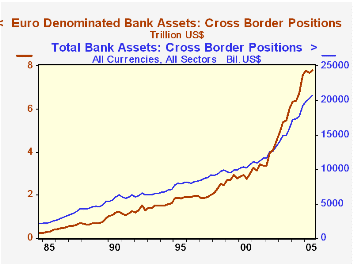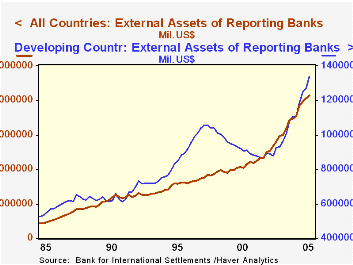 Global| Jan 26 2006
Global| Jan 26 2006BIS Totals $20.7 Trillion in International Banking Assets on 9/30
Summary
The Bank for International Settlements today reported international banking statistics for Q3 2005, on a provisional basis. These data are contained in Haver's BIS database, which includes basically all the tables in the BIS Quarterly [...]

The Bank for International Settlements today reported international banking statistics for Q3 2005, on a provisional basis. These data are contained in Haver's BIS database, which includes basically all the tables in the BIS Quarterly Review. The objective of this highly detailed data collection effort is to provide indications of the exposure of reporting countries' banking systems to international developments. There are 39 reporting countries whose central banks provide comprehensive data on gross external assets and liabilities of their nation's banks with immediate borrowers. These reporting countries are mostly developed countries, but banks in emerging economies, such as Brazil, Mexico and Turkey, also report, along with a number of offshore banking centers. Claims and liabilities are classified by country and sector of the counter-party, by currency and by type of instrument, among other features. Of these 39 countries, 30 also report "consolidated" data, which net out inter-bank flows and indicate the amount of "ultimate" risk, including derivatives as well as on-balance-sheet items. In the following discussion, we look simply at the total of gross claims -- or assets -- for Q3 held by banks in various countries and the distribution of the so-called "vis-à-vis" countries which have incurred them.
At the end of September, external claims of banks in the 39 reporting countries totaled $20.713 trillion. This compares with $20.268 trillion on June 30 and $19,198.3 billion at the end of 2004. The largest claims are assets of banks in the UK, $4.122 trillion. The US is third in this ranking, having $1.965 trillion in foreign assets, while Germany is second at $2.184 trillion. Banks in Japan, France and the Cayman Islands all have more than $1.0 trillion in external assets.
Frequently, in considering banking figures such as these, the public tends to focus on the debts of developing or emerging market countries. But, as measured here, these are smaller than might be expected: BIS reporting banks' assets in these countries came to only $1.338 trillion, 6.5% of the total. In an absolute sense, of course, $1.3 trillion is a large amount, and it probably carries more risk than the substantially bigger assets in more developed countries. The largest claims in this group of countries involve China and South Korea.
By type, loans constitute about three-quarters of these banking system assets. By currency, US dollar assets totaled $8.435 trillion on September 30. The next biggest currency is the euro, with $7.798 trillion. Non-trivial amounts are also denominated in yen, pounds and Swiss francs.
This is a quarterly release, with year-end 2005 likely to be released on April 25. The BIS established these reports as the eurocurrency markets developed in the 1970s. They were enhanced following significant international incidents, especially including the original Mexican debt crisis in 1983 and the Russian default in 1998.
| BIS (All Data in Trillions US $) |
Q3 2005 | Q2 2005 | Q1 2005 | Year-End|||
|---|---|---|---|---|---|---|
| 2004 | 2003 | 2002 | ||||
| Total | 20.713 | 20.268 | 19.808 | 19.198 | 15.999 | 13.370 |
| UK Bank Assets | 4.122 | 4.031 | 3.974 | 37.87 | 3.093 | 2.514 |
| German Bank Assets | 2.184 | 2.167 | 2.191 | 2.151 | 1.786 | 1.384 |
| Claims on Developed Countries | 16.372 | 16.038 | 15.765 | 15.206 | 12.714 | 10.619 |
| Claims on Developing Countries | 1.338 | 1.266 | 1.251 | 1.180 | 1.007 | 0.877 |
| US Dollar Denominated | 8.435 | 8.197 | 7.662 | 7.356 | 6.362 | 5.664 |
| Euro Denominated (US$ value) | 7.798 | 7.663 | 7.760 | 7.564 | 6.026 | 4.501 |
Carol Stone, CBE
AuthorMore in Author Profile »Carol Stone, CBE came to Haver Analytics in 2003 following more than 35 years as a financial market economist at major Wall Street financial institutions, most especially Merrill Lynch and Nomura Securities. She had broad experience in analysis and forecasting of flow-of-funds accounts, the federal budget and Federal Reserve operations. At Nomura Securities, among other duties, she developed various indicator forecasting tools and edited a daily global publication produced in London and New York for readers in Tokyo. At Haver Analytics, Carol was a member of the Research Department, aiding database managers with research and documentation efforts, as well as posting commentary on select economic reports. In addition, she conducted Ways-of-the-World, a blog on economic issues for an Episcopal-Church-affiliated website, The Geranium Farm. During her career, Carol served as an officer of the Money Marketeers and the Downtown Economists Club. She had a PhD from NYU's Stern School of Business. She lived in Brooklyn, New York, and had a weekend home on Long Island.





